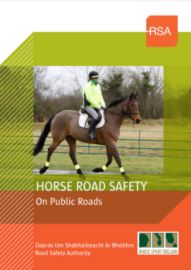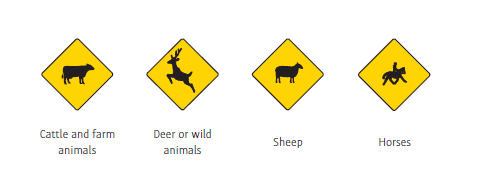Transportation and use of animals on roads
Whether you're taking your horse on a leisurely hack or bringing your pooch on a road trip, it's important to follow the rules of the road to ensure safety for all. We offer advice on the transportation and use of animals on our roads, and explain what to do if you come across one while driving.
Horse road safety
Riding on the road may be part of a horse’s training programme or just for leisure. For riders, it's an enjoyable change of environment, but there are risks. These include traffic speeds, road surfaces and other road users. Road safety knowledge and training will help you reduce these risks.
Horses and riders have every right to be on our roads. However, when you take a horse on the road you must have a clear understanding of and follow the Rules of the Road that apply to you.
- If you’re riding a horse, you must stay on the left-hand side of the road, and follow the Rules of the Road such as obeying road signs and giving clear hand signals.
- When you are leading a horse, you should walk on the left-hand side of the road and position yourself between your horse and passing vehicles. This helps prevent the horse from interfering with traffic.
- When riding one horse and leading another, you must stay on the left-hand side of the road. You should ensure that the led horse is to the left of the ridden horse. That way, you’re positioned between the horse being led and the traffic.
- You should wear a high visibility vest and an approved riding helmet.
- Before riding on the road, you should always tell someone where you intend to go and when you will be back.
- If you are in charge of a horse on a roadway, you must make sure the horse does not block other traffic or pedestrians.
- It is best not to bring a horse and cart on the road at night. If you do, you should carry a lamp on the cart showing a white light to the front and a red light to the back. You should also wear reflective clothing and put suitable reflective equipment on the horse.
- If the weather is bad, you should not ride on the road unless it is absolutely necessary. Motorists will already be experiencing difficult driving conditions and meeting an anxious horse may present a dangerous situation.
Most collisions on the road involving horses happen when the horse is struck from behind. Horses and their riders are extremely vulnerable in a collision and can be seriously injured or killed.
The video below explains how to approach and overtake a horse on the road.
It's important to:
- always be careful when passing horses and riders on the road. A horse may startle. The rider may be a child or an adult in training. Never pass unless it is safe to do so.
- be alert when approaching riding schools or places where horses are likely to appear.
- take special care when overtaking horses, especially loose horses or horse-drawn vehicles. This is particularly relevant at junctions where motorists are advised to keep a safe distance from horses and riders.
- slow down when approaching a horse and rider. Be prepared to stop and let them pass.
- obey a signal to slow down or stop from someone in charge of a horse. They may know about a potential hazard which you cannot see or hear.
- pass by slowly, driving wide of the horse and rider.
- never use your horn or lights in a way that might startle or blind a horse. This could cause the rider to lose control of the animal.
- take special care when passing horses if you are carrying a roof load or towing a trailer
- know the dimensions of your load If you drive a heavy goods vehicle. Be aware that the sound of airbrakes might startle a horse. Show courtesy to riders and their horses and take steps to minimize engine and other noise when passing safely.
Always drive at a speed that allows you to stop:
- safely in a controlled way;
- on the correct side of the road;
- within a clear distance; and
- without risk to you, your passengers or other road users.
/horse-rider-on-public-road.jpg?Status=Master&sfvrsn=9cbddaf_3)

Horse road safety booklet
Download and read our Horse Road Safety booklet for more information and advice about taking horses onto roads.
Safe transportation of pets
Your pet must be safely secured at all times in a vehicle using a seatbelt harness, carrier or dog cage/guard. At 50 km/h, a border collie would be thrown with a force equivalent to nine grown men. Unrestrained pets can also distract a driver, potentially causing a collision and serious injury to all.
/dog-in-car.jpg?sfvrsn=c996c423_5)
Road safety advice for the transportation of pets
You should drive in a way that keeps you and your pet calm and safe. Avoid heavy braking, accelerating and steering sharply. Plan breaks if you are going to be travelling on a long journey. You should also avoid feeding your pet before a journey in order to reduce the chances of them becoming travel sick.
Do not let your pet put their head out of the window as they may fall/jump out or hit their head on a passing object, injuring themselves or others. Grit and debris can also get into their eyes, nose and throat.
For medium or large sized dogs, you should purchase a safety harness that attaches to the car seatbelt. This harness should go around your dog’s chest, back and shoulders and be securely attached to a fastened car seatbelt.
When buying a harness, ask yourself the following questions:
- Can I use this harness in my vehicle?
- Is this harness suitable for my dog’s size and weight?
- Does this harness fit my dog properly and comfortably? (you should be able to fit two fingers between the harness and the dog)
- Will they chew through it?
It is important to make sure that your dog can't get entangled in the harness, as this will be uncomfortable for them and could distract the driver.
For smaller dogs, cats, and other pets, a carrier is a great option. This must be the correct size and should be held properly in place with a seatbelt or by wedging it firmly in the footwell.
Never put a carrier in the boot of a saloon car as your pet could suffocate. Avoid putting it unsecured in the boot of a hatchback or estate car, as the carrier will be thrown around as a result of harsh braking or a crash.
A travel cage or crate is suitable for dogs and larger animals. It is important to make sure the cage is the correct size for your pet; the pet must have enough space to lie down and move comfortably.
Leave plenty of space around the crate to allow for ventilation, and ensure it is secured with the seatbelt. In a hatchback or estate (not saloon) car, a cage can be attached to anchorage points in the boot.
A dog guard, installed between the back of the car and the boot, will keep your dog away from the driver and passengers but will not protect the animal in a crash. For some vehicles, accessory kits are available to help build a dog guard.
Most pets should be placed in a carrier before you put them in your vehicle. If you're not using a carrier, keep them on a lead while they are getting in and out of the vehicle and ensure that they use the door on the pavement side.
Never leave your pet in alone in a vehicle, especially on a particularly hot or cold day. This can be fatal.
- Make sure that your pet will not be struck by any airbags if they go off.
- Try taking your pet on short journeys before gradually building them up to longer trips to get them used to travelling in your vehicle, and ensure you start travelling with them from a young age.
- Keep your vehicle well ventilated.
Transportation of large animals
If you are in charge of animals on a roadway, you must take reasonable steps to make sure the animals do not block other traffic or pedestrians. At night, you should always wear wear a reflective vest and carry a lamp showing a white light to the front and a red light to the back.
If you are transporting larger animals eg horses, cattle and sheep etc, you will need to comply with rules in relation to the towing of trailers and you will also need to have an appropriate driving licence category to tow them.
Rules of the road for towing a trailer
FAQs about Towing rules for agricultural tractors and trailers
Please also see the rules of the road for more information on towing a trailer
/car-and-trialer-868.jpg?sfvrsn=e85d255_3)
Driving Licence and categories for towing a trailer
Transportation of live animals advice on welfare
- Always slow down and be prepared to stop when approaching or overtaking animals.
- If a person in charge of animals gives a signal to slow down or stop, you must obey it.
- Avoid using your horn if animals are in front of you, as it might frighten them.
- If you are travelling on a road where animals are common, you will see a warning sign like these:

